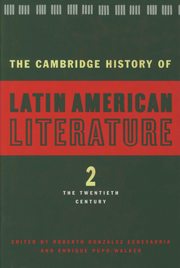Book contents
- Frontmatter
- Introduction to Volume 2
- 1 Modernist poetry
- 2 Modernist prose
- 3 The Vanguardia and its implications
- 4 The literature of Indigenismo
- 5 Afro-Hispanic American literature
- 6 The Criollista novel
- 7 The novel of the Mexican Revolution
- 8 The Spanish American novel from 1950 to 1975
- 9 The Spanish American novel: recent developments, 1975 to 1990
- 10 Spanish American poetry from 1922 to 1975
- 11 The modern essay in Spanish America
- 12 Literary criticism in Spanish America
- 13 The autobiographical narrative
- 14 The twentieth-century short story in Spanish America
- 15 Spanish American theatre in the twentieth century
- 16 Latin American (Hispanic Caribbean) literature written in the United States
- 17 Chicano literature
- Index
- Bibliographies
- References
14 - The twentieth-century short story in Spanish America
Published online by Cambridge University Press: 28 March 2008
- Frontmatter
- Introduction to Volume 2
- 1 Modernist poetry
- 2 Modernist prose
- 3 The Vanguardia and its implications
- 4 The literature of Indigenismo
- 5 Afro-Hispanic American literature
- 6 The Criollista novel
- 7 The novel of the Mexican Revolution
- 8 The Spanish American novel from 1950 to 1975
- 9 The Spanish American novel: recent developments, 1975 to 1990
- 10 Spanish American poetry from 1922 to 1975
- 11 The modern essay in Spanish America
- 12 Literary criticism in Spanish America
- 13 The autobiographical narrative
- 14 The twentieth-century short story in Spanish America
- 15 Spanish American theatre in the twentieth century
- 16 Latin American (Hispanic Caribbean) literature written in the United States
- 17 Chicano literature
- Index
- Bibliographies
- References
Summary
Story or history
The existing accounts of the Spanish American short story consist almost completely of conventional literary history: the modern short story is said to have been born with Echeverría or Palma or Darío or Quiroga, to have been descended from earlier sources in the Spanish or indigenous or mestizo traditions, to have developed or matured or produced such progeny as Borges and Rulfo and Bombal. Attention is not usually called to the organicist metaphors at work in these accounts, the authors seeming to find them beyond question. The literary historian’s task, as defined in the manuals by Leal, Menton, and others, consists of a taxonomy by movements (Naturalism, mundonovismo, criollismo, the fantastic, Neorealism), by generations (the Generations of 1930, 1938, 1940, 1950, and so on, depending on the history of the country in question, or the “first,” “second,” and “third” generations of writers of the Mexican Revolution), by country or region, or by the gender or ethnic origin of the writers; sometimes, indeed, an uneasy combination of all of the above forms the “history.” There is no agreement between the different accounts of this supposed “history,” and indeed no agreement would be possible, given the uncertain foundations on which these accounts are built. It is not even very certain that a “history” of the short story genre in Spanish America could be written: the notion of the short story as genre has been vigorously debated internationally, and in Spanish America the constitution and preservation of such a genre is problematized by the uncertain relations between the “short story” and the “costumbrista sketch,” the “tradición” and the “crónica.”
- Type
- Chapter
- Information
- The Cambridge History of Latin American Literature , pp. 465 - 496Publisher: Cambridge University PressPrint publication year: 1996



